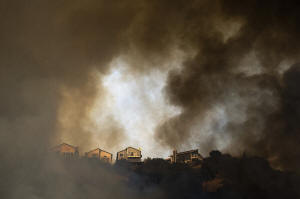Smoke from climate-fueled wildfires contributed to thousands of US
deaths over 15 years, study says
[May 08, 2025]
By DORANY PINEDA
Wildfires driven by climate change contribute to as many as thousands of
annual deaths and billions of dollars in economic costs from wildfire
smoke in the United States, according to a new study.
The paper, published Friday in the journal Nature Communications Earth &
Environment, found that from 2006 to 2020, climate change contributed to
about 15,000 deaths from exposure to small particulate matter from
wildfires and cost about $160 billion. The annual range of deaths was
130 to 5,100, the study showed, with the highest in states such as
Oregon and California.
“We’re seeing a lot more of these wildfire smoke events,” said Nicholas
Nassikas, a study author and a physician and professor of medicine at
Harvard Medical School. So he and multidisciplinary team of researchers
wanted to know: "What does it really mean in a changing environment for
things like mortality, which is kind of the worst possible health
outcome?”
Lisa Thompson, a professor at Emory University who studies air pollution
and climate change and was not involved in the paper, said it is one of
the first studies she has seen to isolate the effect of climate change
on mortality. Looking at the impacts across time and space also made it
unique, she said.
The paper's researchers focused on deaths linked to exposure to fine
particulate matter, or PM2.5 — the main concern from wildfire smoke.

These particles can lodge deep into lungs and trigger coughing and itchy
eyes with short-term exposure. But longer term they can make existing
health problems worse and lead to a range of chronic and deadly health
issues. Children, pregnant people, the elderly and outdoor workers are
among the most vulnerable. The Health Effects Institute estimated the
pollutant caused 4 million deaths worldwide.
Evidence is emerging that PM2.5 from wildfire smoke is more toxic than
other pollution sources. When wildfires encroach into cities, burning
cars and other toxics-containing materials, it adds to the danger.
Numerous studies have tied human-caused climate change — caused by the
burning of coal, oil and gas — to a growth in fires in North America.
Global warming is increasing drought, especially in the West, and other
extreme weather. Drier conditions suck moisture from plants, which act
as fuel for fires. When drier vegetation and seasons are mixed with
hotter temperatures, that increases the frequency, extent and severity
of wildfires and the smoke they spew.
Findings dismaying but not surprising, scholar says
Jacob Bendix, professor emeritus of geography and environment at
Syracuse University, said he was “dismayed” by the findings but not
surprised.
“(T) hese numbers are really significant. I think there’s a tendency for
people outside of the areas actually burning to see increasing fires as
a distant inconvenience … This study drives home how far-reaching the
impacts are,” said Bendix in an email. He wasn't involved in the study.

[to top of second column]
|

Smoke rises above homes as a grass fire burns near Interstate 580 in
Oakland, Calif., Friday, Oct. 18, 2024. (AP Photo/Noah Berger, File)
 The study’s authors drew on modeled
and existing data to reach their findings. First, they sought to
understand how much area burned by wildfires was attributable to
climate change. They did that by analyzing the real climate
conditions — heat and rain, for instance — when wildfires erupted
from 2006 to 2020, and compared that to a scenario where weather
measurements would be different without climate change.
From there, they estimated the levels of PM2.5 from wildfire smoke
tied to climate change using the same approach. Lastly, integrating
the current understanding of how particulate matter affects
mortality based on published research, they quantified the number of
deaths related to PM2.5 from wildfires and calculated their economic
impact.
This framework showed that of 164,000 deaths related to
wildfire-PM2.5 exposure from 2006 to 2020, 10% were attributable to
climate change. The mortalities were 30% to 50% higher in some
western states and counties.
Questions about the study's conclusions
Marshall Burke, global environmental policy professor at Stanford
University, said the evidence linking climate change to burned areas
was “rock solid,” but the subsequent steps were harder.
“Linking burned area to smoke is trickier because you never know
exactly which way the wind’s going to blow,” he said, and he
wondered how the death estimates compared to fatalities tied to
general air pollution.
Still, their approach was sensible and reasonable, Burke said.
Johns Hopkins University lecturer in climate and energy policy
Patrick Brown said he had some concerns about the study. One was
conceptual. The study acknowledges the power non-climate drivers
have on wildfires, but it doesn't give them proper weight, he said
in an email.

Brown, who was not involved in the study, worries decision-makers
could wrongly conclude that mitigating planet-warming carbon
emissions is the only solution. “Yet in many regions, the more
immediate life‑saving action may be fuel breaks, prescribed burns,
ignition‑source regulation, public health efforts, etc.,” he said.
Land management practices such as prescribed burns can reduce
wildfire fuel, Nassikas said. But ultimately, the study notes, the
problem of deaths from wildfire smoke will only get worse without
the reduction of greenhouse gas emissions.
“Part of the study is raising awareness," he said. “And then once we
kind of understand that … now what are the interventions that we can
deploy at a personal level, at a community level, and then obviously
at a larger level across the country and across the world?”
All contents © copyright 2025 Associated Press. All rights reserved |